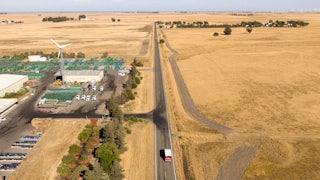“We have a strong economy,” Jerome Powell, chairman of the Federal Reserve, told Scott Pelley of 60 Minutes on Sunday’s broadcast. “Growth is going on at a solid pace. The labor market is strong: 3.7 percent unemployment. And inflation is coming down.” The interview was taped three days before it aired, depriving Powell of the opportunity to add that the economy created 353,000 new jobs in January. Powell might also have mentioned that gross domestic product rose 3.3 percent in the last quarter of 2023. Both indicators exceeded expectations.
Even the public is starting to recognize that the economy is in excellent health. Consumer confidence rose in January for the third straight month, and the percentage of Americans who told Gallup in January that the economy was “excellent” or “good” rose to 27 percent, up from 19 percent in November. Still, that’s half as many as judged the economy “excellent” or “good” in March 2020, when the Covid pandemic began, and the current “soft landing” from the Fed’s inflation-taming interest rate hikes is doing zero to improve Biden’s approval rating, which remains stuck below 40 percent.
Why are people so slow to recognize a strong economy when they see one? The usual explanation is that they’re still pissed off about inflation. But another reason might be the persistence of layoffs, especially in the tech industry. Since the start of 2024, 132 tech companies have laid off 33,224 employees, according to the website Layoffs.fyi, including 2,500 at PayPal, 1,900 at Microsoft, and 1,000 at Google. That’s a problem, right? Especially when you consider that tech stocks dominate the S&P 500.
But as logical and sane as it may be to conclude that layoffs signal something’s amiss, in today’s economy that presumption is a fallacy. Layoffs do not, in fact, signal anything. Consider: In any given month, the number of people who get laid off is about two million. There’s a little fluctuation, but the number never rises to three million or falls to one million. The biggest fluctuations tend to be spikes in November and December, when layoffs typically increase to accommodate calendar-year budgets. Merry Christmas! You’re fired!
To consider this year’s tech layoffs noteworthy (except to the people who lost their jobs), you have to ignore what happened during the previous two years. In 2023 1,190 tech companies laid off 262,735 workers, according to Layoffs.fyi. In 2022, it was 1,065 tech companies laying off 165,269. Across all industries, layoffs have been a flat line on a graph for more than 20 years, the sole exception being the if-you-blinked-you-missed-it recession of February–April 2020, when Covid spiked the unemployment rate to 13 percent and layoffs briefly peaked at about 13 million.
Otherwise, layoffs are an accepted fact of economic life—so much so that in 2013, when Congress compelled the Bureau of Labor Statistics to cut its (teensy) budget by 5 percent, the agency eliminated its Mass Layoff Statistics program, which collected detailed (and quite useful) information about which industries did the laying off, which regions had the most layoffs, what the demographics were of those who got laid off, and so on.
This conception of layoffs as something unpleasant but fairly routine, like your semiannual trip to the dentist, is a relatively recent development. In his 2006 book, The Disposable American: Layoffs and Their Consequences, Louis Uchitelle, a former business reporter for The New York Times, argues that through the 1970s, “companies avoided layoffs” because “they were a sign of corporate failure and a violation of acceptable business behavior.” That began to change in the 1980s when the Fed, under Paul Volker and his successor, Alan Greenspan, concluded the natural unemployment rate was somewhere between 5.5 and 6 percent; anything below that, they believed, would resurrect the Great Inflation of 1965 to 1982. Consequently, whenever unemployment fell below 6 percent or thereabouts, the Fed jacked up interest rates, boosting unemployment in the name of curbing inflation.
“Tight labor markets are a barrier to layoffs,” Uchitelle writes, “and that barrier came down.” Labor unions were fast declining, reducing their power to contest the Fed’s new doctrine. Deregulation and deindustrialization, which had begun under President Jimmy Carter, further normalized layoffs, along with the corporate mergers, outsourcing, and offshoring that accelerated under President Ronald Reagan. So did rising pressures to boost quarterly profits from pension funds, which expanded during this period from 13 percent to 21 percent of all traded shares.
The last gasp of the old order, Uchitelle suggests, was a February 1996 Newsweek cover story by the veteran business journalist Allan Sloan, headlined “Corporate Killers.” Observing something “new and nasty,” Sloan named it “in-your-face capitalism”:
You lose your job, your ex-employer’s stock price rises, the CEO gets a fat raise. Something is just plain wrong when stock prices keep rising on Wall Street while Main Street is littered with the bodies of workers discarded by big companies.
Sloan’s cover piece made a splash. The Clinton White House responded with a white paper from the Council of Economic Advisers that stated, erroneously, that although layoffs had risen under Reagan and President George H.W. Bush, they were falling under Clinton. Clinton also invited about one hundred top corporate executives to a White House conference on corporate responsibility where in the end “nothing,” Uchitelle reports, “was said about curtailing layoffs.” One attendee, CSX chairman John Snow, who would later be Treasury secretary under President George W. Bush, said the opposite: “We must start with the reality that corporations cannot guarantee a lifetime job any more than corporations have a guarantee of immortality.”
After that, according to Uchitelle, layoffs died as a political issue; within a decade Uchitelle’s New York Times colleague David Leonhardt would condemn “Corporate Killers” as “one of the more alarmist covers you’ll see.” Clinton and successive Democrats justified their indifference to the issue by pointing to low unemployment, which near the end of Clinton’s presidency fell below 4 percent. That was basically Leonhardt’s reasoning too. “Just three years after that article,” Leonhardt wrote, “with the ’90s boom at its peak, polls showed American optimism at an all-time high.” Low unemployment, writes Uchitelle, “became a substitute for job security.”
But why must the price of low unemployment be two million layoffs per month? It certainly wasn’t before the 1970s. In 1968 and 1969, back when the corporate layoff taboo still held, unemployment was below our current 3.7 percent. In 1966 and 1967, it was a whisker higher (3.8 percent). A recent Washington Post story asked why, if the economy is booming, tech companies were laying off workers. It traced the problem to a sell-off of tech stocks in 2022. But that was two years ago! Tech stocks rebounded in 2023, rising in excess of 50 percent as the market got excited about artificial intelligence.
Now tech stocks are “red hot,” according to Barron’s, and the very A.I. that revived them has become the reason to lay workers off. The idea is that A.I. will progress so rapidly that that many fewer employees will be required even at the tech companies that develop it. There’s also talk about tech companies having over-hired during Covid, when homebound customers showered money on technology products. A likelier reason for the layoffs is that tech CEOs want shareholders to believe that as A.I. reduces the need for human workers, money previously diverted to salaries will fund ever more stock buybacks and dividends. Far from signaling that your company is sinking, layoffs now signal that your company is thriving.
Tech was the last holdout. It resisted using layoffs as just another management tool because it wanted to cultivate creative teams and pamper them with cafeteria sushi bars and ping-pong tables and refrigerators overflowing with exotic tropical fruits. Tech workers were once special—the brainworkers in whom Clinton placed his faith as the tech sector boomed through the late 1990s. Now tech workers are just like every other schmuck salaryman, biding their time until they’re right-sized into oblivion. They have joined the two million for whom a layoff is little more than corporate America genuflecting to the Charging Bull sculpture at Broadway and Morris Street in New York’s financial district. The shareholder is king, the worker a necessary burden who becomes less necessary by the hour.










